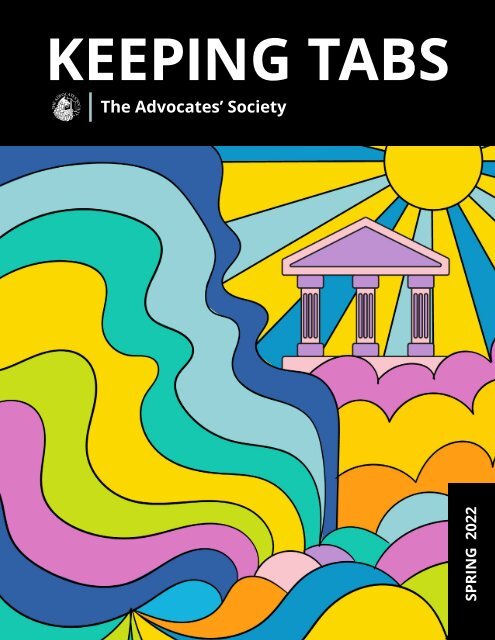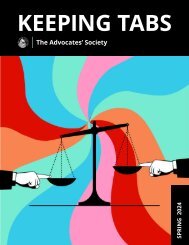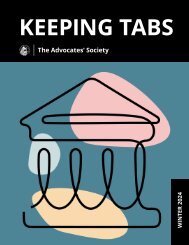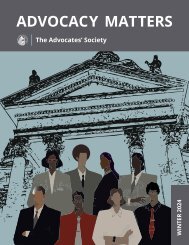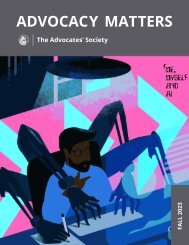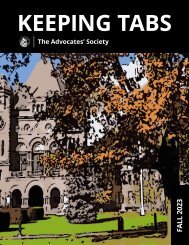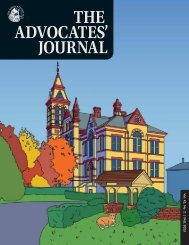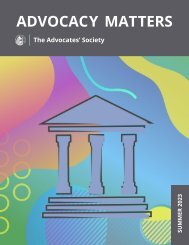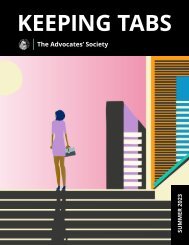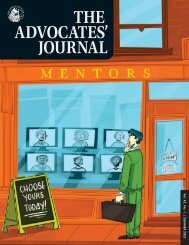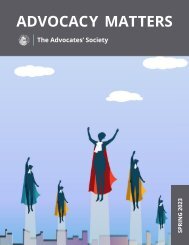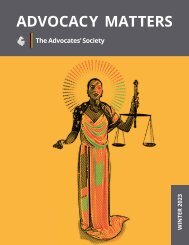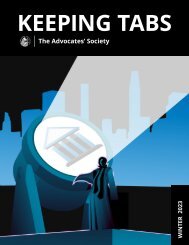Keeping Tabs - Spring 2022
Stay up-to-date on news and events from our Young Advocates' Standing Committee (YASC) with Keeping Tabs.
Stay up-to-date on news and events from our Young Advocates' Standing Committee (YASC) with Keeping Tabs.
Create successful ePaper yourself
Turn your PDF publications into a flip-book with our unique Google optimized e-Paper software.
KEEPING TABS<br />
The Advocates’ Society<br />
SPRING <strong>2022</strong>
Mastering the art and craft of advocacy is a career-long commitment and we are<br />
here to help. The Advocates’ Society has been the premier provider of advocacy<br />
skills training for over 30 years. We are proud to provide lawyers across Canada<br />
with the training and the confidence they need to execute on their feet when it<br />
counts. The Judge will notice…your clients will too.<br />
Visit www.advocates.ca. Be part of the legacy of extraordinary advocates.
CONTENTS<br />
04<br />
06<br />
09<br />
13<br />
16<br />
18<br />
Chair Chat<br />
Erin Pleet, Ross Nasseri LLP<br />
The Legal Professional’s Role in Addressing<br />
Systemic Discrimination of Indigenous Peoples<br />
Zachary Thiffault, Métis Nation of Ontario<br />
Emerging Judicial Guidance–<br />
Tips from Recent Decisions<br />
Vincent DeMarco, Weintraub Erskine Huang LLP<br />
Way of the Future?: The Production and<br />
Preservation of Social Media Evidence<br />
Eleni Loutas, Henein Hutchison LLP<br />
The Charter of Rights and Freedoms – 40 Years On<br />
Patrick MacDonald, City of Hamilton<br />
Interview with Natalia Vandervoort, TD Canada Trust<br />
Compiled by Carlo di Carlo, Stockwoods LLP<br />
Editor: Alexandra Shelley, Torys LLP | ashelley@torys.com<br />
Deputy Editor: Khrystina McMillan, Mathers McHenry & Co<br />
<strong>Keeping</strong> <strong>Tabs</strong> Editorial Team: Carlo Di Carlo, Stockwoods LLP, Patrick J. MacDonald, Sean Petrou, McCarthy Tétrault LLP,<br />
Timothy J.L. Phelan, Cambridge LLP, Sebastian L. Pyzik, Woods S.e.n.c.r.l.<br />
The Young Advocates’ Standing Committee (“YASC”) is a standing committee of The Advocates’ Society with a mandate to be a<br />
voice for young advocates (advocates who are ten years of call or fewer) within the Society and within the profession. We do this<br />
through networking/mentoring events, by publishing articles by and for young advocates, and by raising issues of concern to<br />
young advocates as we work with the Society’s Board of Directors. The opinions expressed by individual authors are their own<br />
and do not necessarily reflect the policies of The Advocates’ Society.<br />
3
CHAIR CHAT<br />
Chair Chat<br />
Erin Pleet, Ross Nasseri LLP<br />
This month marks the 40 th anniversary of the Charter of Rights and Freedoms.<br />
It seems safe to say the introduction of the Charter has been one of the biggest<br />
developments in Canadian law. Imagine what first year constitutional<br />
law classes looked like before it – was it all cases about who gets to regulate<br />
apples, alcohol, and margarine? While federalism is no doubt important (see,<br />
for example, who oversees what aspect of health care during the pandemic),<br />
I am excited to see and read reflections on 40 years of the Charter, and to<br />
dream big on constitutional rights and litigation in the future.<br />
In that vein, take a few minutes to enjoy a celebratory Charter anniversary<br />
quiz compiled by Patrick MacDonald. I consider myself a law and trivia<br />
nerd, but some of these had me stumped.<br />
Also in this issue of <strong>Keeping</strong> <strong>Tabs</strong>, Vincent DeMarco of Weintraub Erskine<br />
Huang LLP has written an article on judicial guidance on some of the practical<br />
aspects of modern court proceedings, including best practices for Case-<br />
Lines and when and how to email judicial assistants.<br />
We have an interview with Natalia Vandervoort, who moved from private<br />
practice into an in-house role at TD Bank. Natalia shares insights into her<br />
career path, what it is like working as in-house counsel, as well as tips for<br />
working with in-house lawyers as clients.<br />
Eleni Loutas of Henein Hutchison LLP has written a timely and useful article<br />
about producing and preserving social media evidence. For curiosity’s sake, I ran<br />
a search for “TikTok” (or “Tik Tok”) in CanLII and there are already over 50 hits!<br />
In February <strong>2022</strong>, the Young Advocates’ Standing Committee hosted The Legal<br />
Professional’s Role in Addressing Systemic Discrimination of Indigenous Peoples.<br />
Zachary Thiffault, Barrister & Solicitor, has written a summary of the informative<br />
and well-attended event. Zachary has included a number of links<br />
and other resources we can review to further our efforts in reconciliation.<br />
If you’d like to contribute to an upcoming edition of <strong>Keeping</strong> <strong>Tabs</strong>, please<br />
email Alex Shelley. To get more involved in YASC, please email our Volunteer<br />
Roster coordinator Lisa Delaney.<br />
Be sure to check your inboxes or follow The Advocates’ Society on Twitter,<br />
LinkedIn and Facebook for the latest on our events and initiatives. We<br />
hope you’ll join us!<br />
4
Now Live! Friends Who Argue - A new TAS podcast jointly<br />
hosted by our Young Advocate and 10+ Standing Committees.<br />
Segments will feature dialogue with the people who get what you<br />
do, as we delve into both the serious and lighthearted aspects of<br />
life as an advocate in Canada. Know a TAS member we should<br />
talk to? Contact Webnesh Haile at WHaile@singleton.com
EVENT REPORT<br />
The Legal Professional’s<br />
Role in Addressing<br />
Systemic Discrimination<br />
of Indigenous Peoples<br />
Zachary Thiffault, Métis Nation of Ontario<br />
On February 9 th , <strong>2022</strong>, the Young Advocates’ Standing Committee hosted<br />
The Legal Professional’s Role in Addressing Systemic Discrimination of Indigenous<br />
Peoples. This panel was organized in answer to the call from the Family<br />
of Colten Boushie to mark February 9 th as a day of action to commemorate<br />
the anniversary of the acquittal of the man responsible for Colten’s death<br />
by making space to address the inequitable treatment of Indigenous peoples<br />
within, and by, the Canadian legal system. Watch nîpawistamâsowin: We<br />
Will Stand Up for more information on Colten’s story, and the ongoing need<br />
to respond to this call to action.<br />
This event brought together a panel of Indigenous lawyers: Margaret<br />
Froh (President of the Métis Nation of Ontario), Alexandra Winterburn<br />
(Senior Associate at Pape, Salter Teillet), Dr. Danielle Lussier (Assistant<br />
6
Professor and Academic Director of the ALOY<br />
Program at the Royal Military College), and<br />
me as moderator. The panelists shared their<br />
insights on what legal professionals can do<br />
to address ongoing systemic discrimination<br />
faced by Indigenous people within, and by,<br />
the legal system:<br />
1. Continue to educate yourselves on the<br />
issues. A resource list for continuing<br />
your education on this topic was created<br />
and sent out to attendees. A copy<br />
can be found here.<br />
2. Take advantage of the unique opportunities<br />
you have as lawyers to remedy<br />
the systemic racism faced by Indigenous<br />
people. For example, encourage<br />
the law school you attended to implement<br />
mandatory courses in Indigenous<br />
peoples and the law in accordance with<br />
the Truth and Reconciliation Commission’s<br />
Call to Action 28.<br />
3. Read the various reports on these matters<br />
and assess how your own practice<br />
or local bar association can work to address<br />
the recommended courses of action<br />
laid out therein.<br />
It is important that we, as legal professionals,<br />
consider the oath we’ve taken and use our critical<br />
thinking to assess where our own actions,<br />
our practices, or the profession more broadly<br />
are contributing to the systemic discrimination<br />
Indigenous peoples face. But to ensure meaningful<br />
change, it is vital that the voices of your<br />
Indigenous colleagues and clients are part of<br />
this conversation. As the late Cree lawyer and<br />
writer, Harold Johnson, said in his book, Peace<br />
and Good Order: “You are never going to find<br />
solutions if you continue to have conversations<br />
about us without us.”<br />
For decades, Indigenous communities and independent<br />
reports and inquiries have called for<br />
changes within the Canadian legal system based<br />
on the manner it engages with Indigenous peoples<br />
and communities. The takeaway from this<br />
panel is that the tools and resources are there,<br />
and now is the time for action. Thank you to<br />
all who attended, those who have committed<br />
to doing the work, and those who we hope will<br />
move beyond asking what they can do and start<br />
taking steps to remedy the ongoing systemic<br />
discrimination Indigenous peoples face within<br />
the Canadian legal system.<br />
7
JUDICIAL GUIDANCE<br />
Emerging Judicial<br />
Guidance – Tips from<br />
Recent Decisions<br />
Vincent DeMarco, Weintraub Erskine Huang LLP<br />
Courts sometimes provide practice tips and guidance to counsel in their<br />
reasons for decisions, especially in the wake of systems such as CaseLines.<br />
It can be easy to overlook the part of a decision that provides direction to<br />
the profession or that touches on an issue that has implications beyond<br />
the particular case at hand. Below are some such tips from the bench coming<br />
out of recent Ontario cases, with guidance for lawyers practising not<br />
only in Ontario but in other provinces and territories as well.<br />
Tip #1: Don’t litigate through judicial assistants<br />
We are always trying to advocate on behalf of our clients, sometimes in<br />
9
emails copying judicial assistants. In Navartnarajah<br />
v. FSB Group Ltd., in the context of a class<br />
action, Justice Morgan cautioned counsel to limit<br />
their email communication with his judicial assistant<br />
to scheduling matters, and directed against<br />
engaging in “full-blown advocacy by email”. 1<br />
Tip #2: Use presentation mode in CaseLines<br />
By now, many of us are familiar with CaseLines.<br />
Typically, counsel will provide a page number reference<br />
or use ‘direct to page.’ In Bowman v. Uwaifo,<br />
an appeal to the Divisional Court from the Consent<br />
and Capacity Board, Justice Myers extolled Case-<br />
Lines’ presentation mode: “the use of Presentation<br />
mode freed me from having to manage CaseLines<br />
to find documents referred to by counsel. It allowed<br />
me to concentrate solely on the merits of counsel’s<br />
arguments and to see the documents quickly and<br />
with no effort or distractions.” 2<br />
According to Justice Myers, such efforts would<br />
“increase the chances of comprehension by the<br />
judge and therefore the persuasiveness of the<br />
presentation” and would also be “likely to garner<br />
some appreciation for the effort to simplify<br />
cumbersome and distracting technical tasks”. 3<br />
(Of course, be sure to take instruction from the<br />
particular decision-maker before whom you are<br />
appearing: some judges or associate judges may<br />
prefer to retain control of their CaseLines.)<br />
Tip #3: Injunctions require a heightened degree<br />
of civility<br />
Cooperation and civility with opposing counsel is<br />
always important but can be more so in the context<br />
of injunctions. In 1162268 Ontario Limited v. Uddin,<br />
4 Justice Dunphy noted that a high degree of civility<br />
and cooperation between counsel is required<br />
if a fair hearing is to be held in the limited time<br />
10
available, failing to take such an approach contributed<br />
to a finding of substantial indemnity costs.<br />
Tip #4: Failure to hyperlink, tab and upload<br />
in CaseLines could sink your motion<br />
Counsel need to ensure that evidence in Case-<br />
Lines is easily navigable: hyperlinks, bookmarks,<br />
and separately-uploaded tabs are all useful<br />
tools to this end.<br />
A failure to hyperlink references in facta<br />
and motion records and upload materials to<br />
CaseLines has been likened by Justice Dunphy<br />
to a request to “sort through an overturned<br />
bowl of spaghetti.” This alone was<br />
more than sufficient to dismiss a motion<br />
(Basaraba v. Bridal Image Inc.). 5<br />
In Monster Snacks Inc. v. David, Associate Justice<br />
Ilchenko required counsel to file fresh as<br />
amended hyperlinked facta and compendia<br />
due to a lack of bookmarks. 6<br />
Another decision, Parekh et al v. Schecter et al,<br />
held that a failure to bookmark delays the administration<br />
of justice. 7<br />
Tip #5: Think twice before scheduling a summary<br />
judgment motion or trying to strike affidavit<br />
evidence<br />
The Courts have long been critical of counsel’s<br />
overuse of the summary judgment path.<br />
Also in Basaraba (referenced above), Justice<br />
Dunphy notified the profession that <strong>2022</strong> would<br />
see a very significant re-allocation of judicial resources<br />
in Toronto away from motions and towards<br />
trial. In spring of <strong>2022</strong>, motion dates are<br />
being booked into December.<br />
Counsel in the Toronto region should be mindful<br />
of the delay they will face in scheduling motions<br />
and only schedule motions for summary judgment<br />
in rare circumstances in the face of this direction.<br />
In a recent Alberta Court of Queen’s Bench decision,<br />
Justice Feasby noted that applications to<br />
strike affidavit evidence are typically not a good<br />
use of the Court’s time. Counsel should reserve<br />
applications to strike such evidence to situations<br />
where it is material and where its admission<br />
would be genuinely prejudicial. 8<br />
Tip #6: The Court retains discretion to require<br />
in-person attendance<br />
Both the Nunavut and B.C. provincial courts<br />
have reiterated that judges should not be<br />
rubber-stamping applications that seek orders<br />
to allow accused, witnesses, and other<br />
participants to appear in court proceedings by<br />
videoconferencing. Counsel making such a request<br />
outside of a provincial practice direction<br />
should be prepared to provide an evidentiary<br />
foundation as the court retains discretion to<br />
require personal attendance. 9<br />
Need some help implementing this practice advice<br />
from the judiciary? TAS has you covered:<br />
- Principles of Civility and Professionalism for<br />
Advocates<br />
- Introduction to Thomson Reuters – CaseLines<br />
- Best Practices for Remote Hearings, Second<br />
Edition<br />
Notes<br />
1. Navartnarajah v. FSB Group Ltd. <strong>2022</strong> ONSC 1757<br />
at paras. 19-20<br />
2. Bowman v. Uwaifo <strong>2022</strong> ONSC 678 at paras. 47-58.<br />
3. Bowman v. Uwaifo <strong>2022</strong> ONSC 678 at paras. 47-58.<br />
4. 1162268 Ontario Limited v. Uddin <strong>2022</strong> ONSC 822 at<br />
paras. 7-8.<br />
5. Basaraba v. Bridal Image Inc., 2021 ONSC 8038,<br />
[Basaraba] at paras. 6-8.<br />
6. Monster Snacks Inc. v. David <strong>2022</strong> ONSC 1647 at para.<br />
19.<br />
7. Parekh et al v. Schecter et al, <strong>2022</strong> ONSC 302 at paras<br />
3-9 (Justice Sharma).<br />
8. Lupuliak v. Condominium Plan No 8211689 <strong>2022</strong> ABQB<br />
65 at para. 35.<br />
11
Free<br />
Member<br />
Resource<br />
Library<br />
NEW CONTENT NOW AVAILABLE<br />
www.advocates.ca
RULES OF EVIDENCE<br />
Way of the Future?:<br />
The Production and<br />
Preservation of<br />
Social Media Evidence<br />
Eleni Loutas, Henein Hutchison LLP<br />
In the movie “The Social Network,” Rooney Mara’s character angrily confronts<br />
Mark Zuckerberg (played by a smarmily perfect Jesse Eisenberg) after<br />
he publishes an insulting online blog post about her. In a pivotal scene, she<br />
yells “the Internet’s not written in pencil, Mark. It’s written in ink!” Although<br />
this scene is gratifying for a myriad of unrelated reasons, this assertion is,<br />
nowadays, subject to qualification. Facebook pages are often private and<br />
Snapchat and Instagram videos will often disappear after a period of time,<br />
13
which can make the “ink” of an individual’s social<br />
media presence much more difficult to see.<br />
The preservation, production and privacy interests<br />
associated with social media evidence<br />
are issues that courts continue to grapple with.<br />
This article addresses two cases which deal<br />
with production of a plaintiff’s “private” social<br />
media content in the personal injury context.<br />
As these cases show, the pervasiveness of social<br />
media does not necessarily entitle a litigant<br />
to unfettered access to an individual’s social<br />
media posts, even where relevant to the legal<br />
issues in an action.<br />
In Merpaw v Hyde, 2015 ONSC 1053, the plaintiff<br />
claimed that she was incapacitated from any<br />
employment, including sedentary, and suffered<br />
from reduced enjoyment of life, depression<br />
and chronic fatigue as a result of a back injury<br />
she suffered after a trip and fall. On a discovery<br />
motion, the defendant sought, amongst other<br />
items, access to the plaintiff’s private Facebook<br />
page. Facebook was the only social media platform<br />
the plaintiff used, and there were ten photographs<br />
on her public page. She was in six of<br />
the ten photographs and, in each, was standing<br />
with her cane or sitting.<br />
In her decision, Justice LeRoy first noted that<br />
the Court can refuse disclosure when the information<br />
is of little importance to the litigation<br />
and disclosure may constitute a serious<br />
invasion of privacy. As there were pictures and<br />
communications on the plaintiff’s public page<br />
that were relevant to the action, it was reasonable<br />
to infer there was relevant information<br />
contained in the private forum; this raised the<br />
enquiry to more than mere fishing, meeting the<br />
defendant’s burden to establish the relevancy<br />
of the documents sought beyond mere specu-<br />
14
lation. However, there was no reason to expect<br />
the private page to contain information that<br />
was inconsistent with her public page and other<br />
evidence in the action. As such, the plaintiff<br />
was not required to produce the content of the<br />
private section of her Facebook.<br />
More recently, in Smith v Jarnell, 2020 ONSC<br />
6433, the plaintiff sustained injuries after a motor<br />
vehicle accident, claiming loss of earning potential<br />
and an inability to participate in household,<br />
recreational, social and athletic activities<br />
to the extent he had participated before the<br />
accident.The defendant sought production of<br />
all posts and photos from the plaintiff’s social<br />
media accounts that showed him participating<br />
in activities or going on trips since the accident.<br />
Relying on Regional Senior Justice Heeney’s decision<br />
in Stewart v. Kempster, 2012 ONSC 7236, the<br />
Court reiterated that “[t]he onus is on the moving<br />
party to establish that the plaintiff’s social<br />
media accounts have relevant information. The<br />
simple existence of a social media account like<br />
Facebook does not meet the test of relevance.”<br />
During the hearing, counsel attempted to<br />
demonstrate that the plaintiff’s social media<br />
account had relevant information in two ways:<br />
first, through a review of the plaintiff’s questions<br />
about his social media on his examination<br />
for discovery and, second, through the<br />
real-time sharing of the plaintiff’s public Facebook<br />
account. With respect to the first method,<br />
although the plaintiff had preserved his Facebook,<br />
Instagram and Snapchat accounts as requested,<br />
he indicated he did not post very often.<br />
He was not asked on discovery whether any<br />
of the postings would be of activity relevant to<br />
limitations he alleges he has experienced since<br />
the accident or any of his complaints in this action.<br />
The discovery evidence was therefore insufficient<br />
to establish the plaintiff’s social media<br />
pages bore any relevance.<br />
Master Jolley held that the second method<br />
of screen-sharing the plaintiff’s public Facebook<br />
page was not evidence; the contents of<br />
the account were not in the motion record or<br />
attached to any affidavit. As it was not in evidence,<br />
the content of the plaintiff’s public social<br />
media account could not be relied upon to establish<br />
the relevance of his private account. As<br />
such, Master Jolley concluded that there was no<br />
evidentiary basis to conclude that any relevant<br />
documents existed on the plaintiff’s social media<br />
platforms to justify an order for production<br />
and this portion of the motion was dismissed.<br />
As social media becomes more pervasive<br />
in our daily lives, it will inevitably continue to<br />
raise interesting evidentiary questions that<br />
may warrant a re-watch of The Social Network.<br />
Consider it CPD!<br />
Interested in learning more about social media<br />
evidence and digital evidence generally?<br />
Check out our Digital Evidence for Litigators program<br />
from March <strong>2022</strong>, available for purchase<br />
as an archived webcast.<br />
15
The Charter of Rights and<br />
Freedoms – 40 Years On<br />
Patrick MacDonald, City of Hamilton<br />
On April 17, 1982, Queen Elizabeth II signed the Constitution Act, 1982 into law in<br />
a rainy outdoor ceremony on Parliament Hill, which means that April 17, <strong>2022</strong><br />
marked the 40 th anniversary of the Charter of Rights and Freedoms.<br />
In honour of 40 years of the Charter, we present this little quiz to see<br />
what you know about this important part of Canadian history!<br />
1. Law Society of Upper Canada v. Skapinker was notable for what?<br />
a. Striking down the Canadian Bill of Rights<br />
b. It is the only time Section 14 of the Charter (interpreter rights) has been adjudicated<br />
c. The Supreme Court finding that the Charter did not apply due to the facts of the case<br />
occurring prior to 1982<br />
d. It was the first Charter decision to reach the Supreme Court<br />
2. Despite playing a key role in constitutional negotiations, which provincial premier was<br />
defeated in a general election just nine days after the signing ceremony with the Queen?<br />
a. Allan Blakeney (Saskatchewan)<br />
b. Bill Davis (Ontario)<br />
c. Brian Peckford (Newfoundland)<br />
d. Robert Stanfield (Nova Scotia)<br />
3. Quebec premier René Lévesque was notable for doing what at the signing ceremony<br />
on April 17, 1982?<br />
a. He wore a Quebec flag pin<br />
b. He turned his back to the Queen<br />
c. He boycotted it and did not attend<br />
d. He signed with an X<br />
16<br />
ANSWERS: 1. d. Decided by the SCC in 1984, 2. a. After 11 years in power, Blakeney’s NDP suffered a huge defeat to the provincial<br />
Section 16.1 was added, 7. b. David Oakes was arrested for possession of 8 grams of hash oil and $619.45. That amount of cannabis
4. As a further protest, Quebec inserted the Notwithstanding Clause into all provincial<br />
legislation from 1982 to 1985. Why did it stop?<br />
a. Because of the delayed coming into force of section 15<br />
b. The Supreme Court ruled that the practice was unconstitutional<br />
c. Quebec made an agreement with Prime Minister Mulroney to re-enter constitutional<br />
negotiations<br />
d. There was a change in government<br />
5. Despite being signed into law in 1982, Section 15 of the Charter did not come into<br />
force until 1985. Why?<br />
a. To allow governments time to review existing statutes for constitutional issues<br />
b. The final language of Section 15 was not yet agreed to<br />
c. To allow for a reference case on that section to the Supreme Court<br />
d. To guarantee at least one more federal general election before coming into force<br />
6. The most recent amendment to the Charter was made in 1993. What was added or<br />
changed?<br />
a. Freedom of the press was expanded to include electronic communications<br />
b. Equal language rights for New Brunswick<br />
c. Mandating fixed election dates for provinces<br />
d. Gender equality rights<br />
7. Due to the recent legislative changes, the fact scenario of which famous Charter<br />
case would likely not attract criminal charges if it happened today?<br />
a. R. v. Stinchcombe<br />
b. R. v. Oakes<br />
c. United States v. Burns<br />
d. R. v. Jordan<br />
8. The Notwithstanding Clause has been brought into force just five times in Canadian<br />
history. Three of those were in Quebec. The most recent was in Ontario in 2021. In<br />
1986, what was the only other province to bring into force legislation invoking the<br />
Notwithstanding Clause, to end a public sector employees’ strike?<br />
a. Alberta<br />
b. New Brunswick<br />
c. Manitoba<br />
d. Saskatchewan<br />
Progressive Conservatives, 3. c, 4. d. The PQ lost the 1985 election and the new Liberal government ceased the practice., 5. a, 6. b.<br />
oil is now legal for individuals to possess., 8. d. Saskatchewan and Premier Grant Devine passed the SGEU Dispute Settlement Act, 1986<br />
17
INTERVIEW<br />
Interview with<br />
Natalia Vandervoort,<br />
TD Canada Trust<br />
Compiled by Carlo di Carlo, Stockwoods LLP<br />
Q. Why did you become a litigator or advocate?<br />
A. As I went through the early stages of my legal career, I enjoyed helping people solve their disputes<br />
and found litigation intellectually stimulating and exciting. Each new case was different and<br />
presented its own novel challenges. I knew litigation was for me when I won a small claims trial as<br />
an articling student and experienced my first court adrenaline rush. There was no turning back.<br />
18<br />
Q. What is your year of call?<br />
A. 2013.
Q. What is your greatest<br />
extravagance in your<br />
everyday life?<br />
A. A monthly wine<br />
subscription from Charlie’s<br />
Burgers Wine Program. Wine<br />
delivered to my door during<br />
lockdown was a necessity.<br />
And, of course, $6 lattes.<br />
Q. What is your favourite part about the practice?<br />
A. My favourite part is developing a strategy for<br />
a case. It is high level, complex and involves a<br />
consideration of many non-legal factors. In-house<br />
lawyers need to digest advice provided by external<br />
counsel and deliver a practical recommendation<br />
to the business. There is so much thinking and<br />
creativity that happens behind the scenes to land<br />
on a decision.<br />
Q. What made you want to make the leap to in-house practice?<br />
A. It was a quick decision for me and was not part of any long-term plan I had. A great opportunity<br />
presented itself to practise securities litigation at TD and I jumped on it a couple of months before<br />
I was due to return to the firm after maternity leave. I thought of it as a chance to enhance my skill<br />
set and see what it’s like to work for a large institution. So far, it’s been a very rewarding experience<br />
that I highly recommend to all litigators (through a secondment, for example). And no, I did not leave<br />
private practice because I wanted a slower pace that would allow me to focus on my family (not that<br />
there is anything wrong with that).<br />
Q. What are the differences between your career now as opposed to when you were at a firm?<br />
A. There are many differences. I could write an essay. The top three that come to mind are: volume,<br />
breadth of experience and the non-linear career path. The number of matters that I am engaged<br />
on is significantly more than in private practice, and on each matter, I do not operate in a silo. I am<br />
always thinking about the broader implications. I also have an opportunity to analyze more diverse<br />
legal issues than at a firm and see the issues presented from all different angles. I often have to be<br />
the first to identify a litigation risk and take steps to address that risk. The last thing I will note is that<br />
a career trajectory in-house is not as linear as at a firm. There is no magic formula to get to General<br />
Counsel and there are many exciting non-legal opportunities available that simply would not be<br />
available to a lawyer at a firm.<br />
19
Q. What are the things about in-house practice that surprised you or that you wished you<br />
understood when you worked at a firm?<br />
A. I think what surprised me the most is the significant and important function the in-house<br />
legal department has. The role is so much more than managing litigation files, which I did not<br />
appreciate when I was at a firm. We are effectively managers of risk.<br />
Q. What advice do you have for younger lawyers looking to make a career change?<br />
A. As they say, change is good and we benefit from shaking things up once in a while. There<br />
is a world outside your current bubble and it’s a big world. There is no guarantee that the<br />
grass will be greener, but you don’t need that guarantee. As long as the career change<br />
could lead to professional growth and it is something that excites you, go for it and don’t<br />
look back. But, please don’t make the decision in a vacuum. Talk to your friends, family and<br />
mentors about your decision to get more perspective.<br />
Q. What advice do you have for lawyers working with in-house lawyers?<br />
A. Be responsive and do what you say, and if you can’t, that’s usually ok, but tell us. No one likes<br />
following up. Learn the business as much as you can and take initiative in doing so. The more you<br />
understand the business, the more of a valuable partner you will become to your in-house lawyer<br />
in resolving disputes. Take initiative to set up touchpoints to discuss the strategy for the matter, if<br />
appropriate, at least once a quarter.<br />
20
The Legal Professional’s Role in Addressing<br />
Systemic Discrimination of Indigenous Peoples<br />
February 9, <strong>2022</strong> | Live Online<br />
Fireside Chat on Advocacy<br />
March 1, <strong>2022</strong> | Live Online<br />
21
www.advocates.ca


